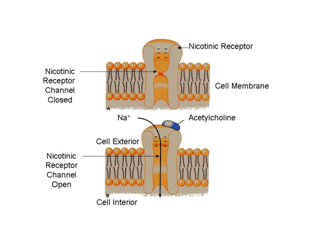User:Alex Pennington/Sandbox 1
From Proteopedia
(→Physiology) |
|||
| Line 10: | Line 10: | ||
=== Physiology === | === Physiology === | ||
| + | |||
| + | The receptor is a cylidrically-shaped protein. It is embedded in the cell wall of post synaptic nerves at the skeletal neuromuscular junction. The receptor acts as a chemically controlled sodium (Na) channel also known as a [[ligand gated channel]]. | ||
| + | |||
| + | When in the presence of [[acetylcholine]], the receptor undergoes a conformational change opening up the channel to an influx of sodium (Na) within the cell. When this happens the cell undergoes a depolarization event that triggers an action potential to propagate along the rest of the cell stimulating, for example, a muscle response. | ||
| + | |||
| + | The opening of these channels only lasts for a millisecond due to [[cholinesterase]] being present and breaking down [[acetylcholine]] attached to the receptor causing the receptor to close again. Introduction of [[cholinesterase inhibitors]] can cause a depolarization block. It works by creating a prolonged refractory period in the depolarization event promoted by the opening of the receptor channel. | ||
=== Locations === | === Locations === | ||
Revision as of 18:43, 2 May 2014
Contents |
Nicotinic Acetylcholine Receptor
|
Structure
Function
Physiology
The receptor is a cylidrically-shaped protein. It is embedded in the cell wall of post synaptic nerves at the skeletal neuromuscular junction. The receptor acts as a chemically controlled sodium (Na) channel also known as a ligand gated channel.
When in the presence of acetylcholine, the receptor undergoes a conformational change opening up the channel to an influx of sodium (Na) within the cell. When this happens the cell undergoes a depolarization event that triggers an action potential to propagate along the rest of the cell stimulating, for example, a muscle response.
The opening of these channels only lasts for a millisecond due to cholinesterase being present and breaking down acetylcholine attached to the receptor causing the receptor to close again. Introduction of cholinesterase inhibitors can cause a depolarization block. It works by creating a prolonged refractory period in the depolarization event promoted by the opening of the receptor channel.
Locations
•skeletal neuromuscular junctions
•sympathetic and parasympathetic nervous system
•autonomic ganglia
•central nervous system
Clinical Findings
Structural highlights
This is a sample scene created with SAT to by Group, and another to make of the protein. You can make your own scenes on SAT starting from scratch or loading and editing one of these sample scenes.
</StructureSection>

